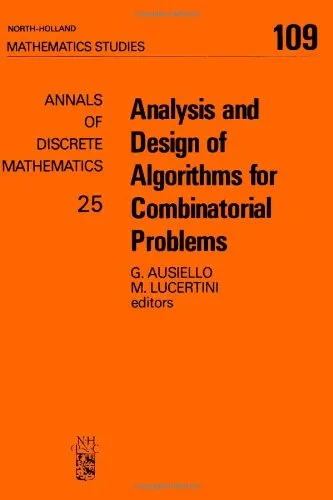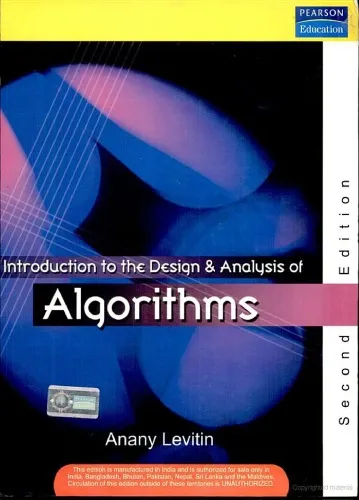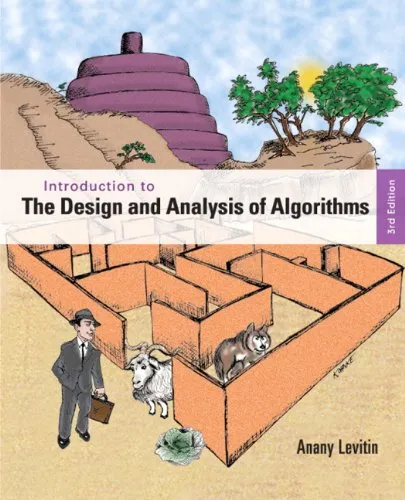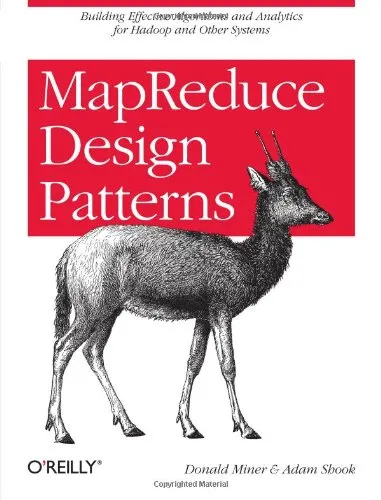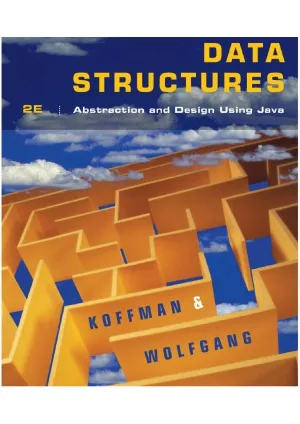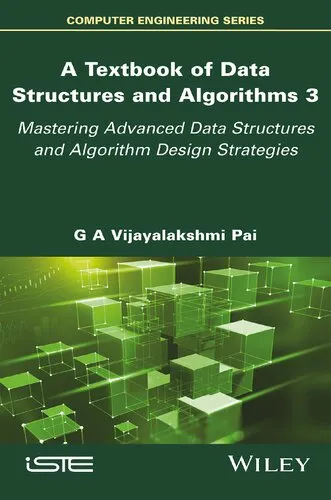Algorithms for VLSI Physical Design Automation, Third Edition
4.0
بر اساس نظر کاربران

شما میتونید سوالاتتون در باره کتاب رو از هوش مصنوعیش بعد از ورود بپرسید
هر دانلود یا پرسش از هوش مصنوعی 2 امتیاز لازم دارد، برای بدست آوردن امتیاز رایگان، به صفحه ی راهنمای امتیازات سر بزنید و یک سری کار ارزشمند انجام بدینکتاب های مرتبط:
معرفی کتاب: Algorithms for VLSI Physical Design Automation, Third Edition
کتاب Algorithms for VLSI Physical Design Automation نوشته نویسنده برجسته، پروفسور "نوید ا.شروانی"، به عنوان یکی از معتبرترین منابع در حوزه طراحی مدارهای مجتمع (VLSI) شناخته میشود. این کتاب نسخه سوم خود را با بهبودهای چشمگیر منتشر کرده است و به طور خاص بر الگوریتمها و فرآیندهای خودکارسازی طراحی فیزیکی متمرکز است. خلاقیت و عمق این کتاب، این اثر را به منبعی ضروری برای دانشجویان، محققان و مهندسان تبدیل کرده است.
خلاصه جامع کتاب
نسخه سوم این کتاب شامل تشریح کامل جنبههای تئوری و عملی طراحی فیزیکی مدارهای VLSI است. تمرکز اصلی این کتاب بر بهینهسازی مسائل طراحی میباشد، از جمله floorplanning, placement, و routing. مباحث کتاب در سطوح مختلفی ارائه شده است تا دانشجویان کارشناسی، کارشناسی ارشد و حتی متخصصان حرفهای بتوانند از آن بهرهمند شوند. یکی از ویژگیهای برجسته کتاب، توجه به جزئیات و توضیح دقیق الگوریتمها همراه با مثالهای واقعی است.
مباحث اصلی این کتاب شامل موارد زیر است:
- درک اصول اولیه طراحی فیزیکی VLSI
- تشریح الگوریتمهای گام به گام برای طراحی و پیادهسازی
- پرداختن به پیچیدگیهای عملیاتی در floorplanning و placement
- راهکارهای مدرن برای مسیریابی یا routing
- بررسی تنوع گستردهای از الگوریتمهای بهینهسازی
نکات کلیدی که از کتاب خواهید آموخت
این کتاب نه تنها به آموزش الگوریتمها و فرآیندها میپردازد بلکه به خوانندگان کمک میکند تا مهارتهای طراحی VLSI خود را به سطح بالاتری ارتقا دهند. برخی از نکات کلیدی عبارتند از:
- چگونه مسائل عمده طراحی فیزیکی را شناسایی و طبقهبندی کنیم.
- فهم تاثیر الگوریتمهای مختلف بر کیفیت طراحی.
- بهکارگیری فنون پیشرفته CAD برای حل مسائل واقعی.
- چگونه تعادل بین هزینهها، عملکرد و کارایی در طراحی برقرار کنیم.
جملات مشهور از کتاب
"Design automation is the path to achieving scalable solutions in modern VLSI."
"Physical design is where art meets science—it's the backbone of high-performance circuit realization."
چرا این کتاب اهمیت دارد؟
با پیشرفت سریع تکنولوژی نیمههادیها و افزایش پیچیدگی مدارهای مجتمع، بهینهسازی فرآیندهای طراحی فیزیکی یک امر حیاتی شده است. این کتاب میانبری برای درک این فرآیندها ارائه میدهد و در عین حال شما را با مهمترین روشهای خودکارسازی طراحی آشنا میسازد. اهمیت کتاب در این است که به شما کمک میکند با چالشهای بزرگ در حوزه طراحی VLSI روبهرو شوید و آنها را به شکلی کارآمد حل کنید. خواندن این کتاب، شما را برای کار با ابزارهای مدرن CAD و حل مسائلی همچون placement و routing آماده میکند.
برای افرادی که به دنبال مطالعهای جامع در مورد الگوریتمهای طراحی فیزیکی هستند، این کتاب گنجینهای از دانش و تجربه است.
Introduction to "Algorithms for VLSI Physical Design Automation, Third Edition"
Written by Naveed A. Sherwani, "Algorithms for VLSI Physical Design Automation, Third Edition" is a comprehensive guide to the intricate world of Very-Large-Scale Integration (VLSI) physical design. This book serves as a cornerstone resource for students, researchers, and professionals in the field of VLSI design automation. With its structured approach, it lays out the complete landscape of algorithms, methodologies, and techniques that enable efficient physical design automation.
As the VLSI systems grow in complexity and scale, the automation of physical design processes becomes increasingly critical in ensuring optimized performance. This book provides theoretical foundations as well as practical solutions that cater to real-world challenges in the VLSI design space. Whether you are an academic diving into research or an engineer seeking scalable solutions to design problems, this book serves as a definitive guide to mastering the art of VLSI physical design algorithms.
Summary of the Book
The book comprehensively covers all aspects of VLSI physical design automation, including placement, partitioning, floorplanning, and routing. By delving into essential algorithms, it evaluates their efficiency, design considerations, and applicability for modern VLSI processes.
The book is structured to progressively introduce topics, starting with fundamental design automation concepts. Some of the covered topics include:
- Overview of VLSI physical design stages and processes.
- Partitioning algorithms for dividing circuits into manageable sections.
- Detailed exploration of floorplanning techniques to optimize chip layout.
- Placement techniques that determine the positions of circuit elements for performance efficiency.
- Routing algorithms, with emphasis on global and detailed routing strategies.
- Advanced topics such as timing closure, performance trade-offs, and power efficiency.
The book balances theoretical depth with practical examples, providing readers the tools they need to both understand and implement complex VLSI algorithms. It is organized to serve as a textbook for courses while simultaneously acting as a practical handbook for professionals in the industry.
Key Takeaways
The primary takeaways from this book revolve around its ability to bridge the knowledge gap between theoretical concepts of algorithms and their pragmatic use within the VLSI design automation landscape. Here are some of the key takeaways:
- Develop a deep understanding of fundamental and advanced algorithms used in physical design automation.
- Learn how to optimize design flows for performance, area, and power consumption in modern integrated circuits.
- Explore the interplay between computational complexity and practical implementation in the physical design processes.
- Gain insights into handling challenges introduced by ever-increasing chip densities and smaller technology nodes.
- Master modern practices, methodologies, and tools that are central to VLSI chip design workflows.
Famous Quotes from the Book
The book features many thought-provoking perspectives on VLSI physical design algorithms. Below are some notable quotes:
"The success of physical design automation lies in its ability to effectively balance computational complexity and system requirements."
"Algorithms are the true enablers of innovation in VLSI design; they transform art into science and interruptions into opportunities."
"Physical design is where hardware meets geometry, and optimization meets creativity."
Why This Book Matters
"Algorithms for VLSI Physical Design Automation, Third Edition" stands out as a seminal work in the domain of VLSI design. Here's why it matters:
- It has become a standard reference text for studying and implementing VLSI physical design algorithms in both academia and industry.
- The book addresses the unique challenges posed by scalable designs in an era marked by technological miniaturization.
- It presents a well-rounded perspective on how theoretical principles translate into real-world engineering solutions.
- The book’s emphasis on algorithmic frameworks empowers readers to solve highly complex design problems efficiently.
- It lays the groundwork for future advancements in VLSI physical design by educating and inspiring the next generation of engineers and researchers.
Overall, this book continues to be a critical resource for anyone aiming to excel in the advanced field of VLSI physical design automation. With its detailed explanations, balanced focus on theory and applications, and emphasis on algorithmic thinking, it remains a timeless companion for VLSI enthusiasts.
دانلود رایگان مستقیم
شما میتونید سوالاتتون در باره کتاب رو از هوش مصنوعیش بعد از ورود بپرسید
دسترسی به کتابها از طریق پلتفرمهای قانونی و کتابخانههای عمومی نه تنها از حقوق نویسندگان و ناشران حمایت میکند، بلکه به پایداری فرهنگ کتابخوانی نیز کمک میرساند. پیش از دانلود، لحظهای به بررسی این گزینهها فکر کنید.
این کتاب رو در پلتفرم های دیگه ببینید
WorldCat به شما کمک میکنه تا کتاب ها رو در کتابخانه های سراسر دنیا پیدا کنید
امتیازها، نظرات تخصصی و صحبت ها درباره کتاب را در Goodreads ببینید
کتابهای کمیاب یا دست دوم را در AbeBooks پیدا کنید و بخرید
1280
بازدید4.0
امتیاز0
نظر98%
رضایتنظرات:
4.0
بر اساس 0 نظر کاربران
Questions & Answers
Ask questions about this book or help others by answering
No questions yet. Be the first to ask!


